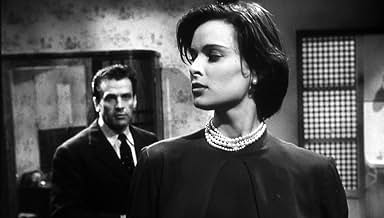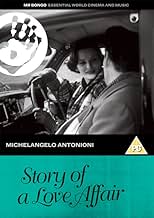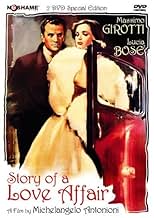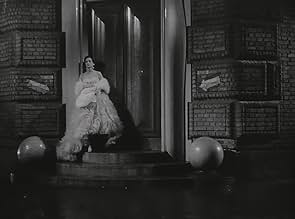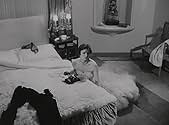NOTE IMDb
7,1/10
3,7 k
MA NOTE
Ajouter une intrigue dans votre languePaola is a young, beautiful woman married to a wealthy entrepreneur. She meets her former lover Guido after seven years, but their relationship is marked by tragic events.Paola is a young, beautiful woman married to a wealthy entrepreneur. She meets her former lover Guido after seven years, but their relationship is marked by tragic events.Paola is a young, beautiful woman married to a wealthy entrepreneur. She meets her former lover Guido after seven years, but their relationship is marked by tragic events.
- Réalisation
- Scénario
- Casting principal
- Récompenses
- 2 victoires et 1 nomination au total
Rubi Dalma
- L'amica snob di Paola
- (as Rubi D'Alma)
Rosi Mirafiore
- La cameriera del bar
- (as Rosi Mirafiori)
Franco Fabrizi
- Il presentatore della sfilata di moda
- (non crédité)
Avis à la une
This is Antonioni's first feature. Released in 1950, it seems to me both a harbinger of the auturer's mature style while also being a semi- remake, semi- rebuke of Double Indemnity., from only a few years prior. .
There is an extraordinary shot in this film, pure Antonioni, when the lovers meet on a bridge. The view is 360 degrees, we're not sympathizing with one lover more than the other. As the camera moves around its axis, our focus goes much beyond our traditionally intended targets as ship workers in the distance cohabitate the deepest focus with the characters we are following, who bicker over the merits of violating social morality.
If Double Indemnity is fatalistic, this work is nihilistic. If traditional Noir-narrative leads to certain doom, this story leads to only one finality, and that is the randomness and chaos of life, death and love. In that way, this work reminded me most of Woody Allen's late- career "thrillers"-Match Point and Cassandra's Dream.
There is an extraordinary shot in this film, pure Antonioni, when the lovers meet on a bridge. The view is 360 degrees, we're not sympathizing with one lover more than the other. As the camera moves around its axis, our focus goes much beyond our traditionally intended targets as ship workers in the distance cohabitate the deepest focus with the characters we are following, who bicker over the merits of violating social morality.
If Double Indemnity is fatalistic, this work is nihilistic. If traditional Noir-narrative leads to certain doom, this story leads to only one finality, and that is the randomness and chaos of life, death and love. In that way, this work reminded me most of Woody Allen's late- career "thrillers"-Match Point and Cassandra's Dream.
Suffering is an inate response to life, this is one of the inescapable principles of existence. Antonioni saw far in the career that followed, farther than perhaps any director in cinema, but here he begins where it's proper, with life as a cycle of suffering, a seemingly random pattern of recurring time where we're denied what we most desire, happiness eludes us and our dreams and hopes are thwarted and frustrated.
Too young to see a true reality, Antonioni nonetheless sees clearly the reality of illusions. First that the cycle we call life is not blindly, randomly spun, and that we're to be held accountable for our part in the spinning, foremostly that our pursuit of happiness as we like to think is really the deluded pursuit of satisfying desire.
The crucial point that connects these is, rather poignantly, a death, and it happens not once but twice, mirrored identical the second time like a prefiguration of Vertigo. As with Vertigo, this borrows the world of film noir to speak of karmic wheels and the mechanisms that control them, a Double Indemnity scenario where secret lover and wife calculate to get rid of the rich husband.
In a magical touch, the plotted murder happens of its own accord, seemingly out of the whim of an agent of a higher court passing by.
It's not then just a matter of what begins as thought and desire invariably manifests in imminent reality, this is a powerful inspection of mind, but moreover that having devoted themselves by all means to the pursuit of that desire, a passion born of ego and craving, the obstacle that stood in their way now removed, the two protagonists realize how impotent they remain to pursue that desire, how desire is by its nature an insatiable attribute. Their punishment, which is not divine but of their own doing, is the toll exacted on their conscience.
This first appearance in Antonioni of karma as the force that keeps going the cycle of suffering is not perfect by any means, it seems at the same time to imply questions of moral order, whether or not for example wishing for a crime to happen is a crime in itself, spiritual in nature. And all of this is more verbose than need be, something Antonioni would excise in a few years.
We find things in this debut that Antonioni would elaborate upon in wonderful ways, the ineffability of connection, the city as a cold, alienating limbo where souls in transit struggle for meaning, the transparent reality that extends outside the frame to suggest an entire world and flow of life with or without these characters (indeed we find here, abetting this, the beginnings of his amazing sound work, where the city traffic is always audible), but all these are in nascent form here.
What stands out for me is the true perception that begins to form in Antonioni's cinema. Meaning our idea of reality is just that, an idea born of our own habits and various storytellings, which clouds our soul and needs to be challenged, dismantled, removed from our eyes so that we can see life as it is.
Too young to see a true reality, Antonioni nonetheless sees clearly the reality of illusions. First that the cycle we call life is not blindly, randomly spun, and that we're to be held accountable for our part in the spinning, foremostly that our pursuit of happiness as we like to think is really the deluded pursuit of satisfying desire.
The crucial point that connects these is, rather poignantly, a death, and it happens not once but twice, mirrored identical the second time like a prefiguration of Vertigo. As with Vertigo, this borrows the world of film noir to speak of karmic wheels and the mechanisms that control them, a Double Indemnity scenario where secret lover and wife calculate to get rid of the rich husband.
In a magical touch, the plotted murder happens of its own accord, seemingly out of the whim of an agent of a higher court passing by.
It's not then just a matter of what begins as thought and desire invariably manifests in imminent reality, this is a powerful inspection of mind, but moreover that having devoted themselves by all means to the pursuit of that desire, a passion born of ego and craving, the obstacle that stood in their way now removed, the two protagonists realize how impotent they remain to pursue that desire, how desire is by its nature an insatiable attribute. Their punishment, which is not divine but of their own doing, is the toll exacted on their conscience.
This first appearance in Antonioni of karma as the force that keeps going the cycle of suffering is not perfect by any means, it seems at the same time to imply questions of moral order, whether or not for example wishing for a crime to happen is a crime in itself, spiritual in nature. And all of this is more verbose than need be, something Antonioni would excise in a few years.
We find things in this debut that Antonioni would elaborate upon in wonderful ways, the ineffability of connection, the city as a cold, alienating limbo where souls in transit struggle for meaning, the transparent reality that extends outside the frame to suggest an entire world and flow of life with or without these characters (indeed we find here, abetting this, the beginnings of his amazing sound work, where the city traffic is always audible), but all these are in nascent form here.
What stands out for me is the true perception that begins to form in Antonioni's cinema. Meaning our idea of reality is just that, an idea born of our own habits and various storytellings, which clouds our soul and needs to be challenged, dismantled, removed from our eyes so that we can see life as it is.
In Milano, when the wealthy and jealous entrepreneur Enrico Fontana (Ferdinando Sarmi) discovers hidden photos of his gorgeous twenty-seven year-old wife Paola Molon Fontana (Lucia Bosé), he hires a Neapolitan detective agency to investigate her past. Enrico, who owns twenty companies, married Paola during the war in March 1943 and her past is unknown to him. Detective Morale Carloni (Gino Rossi) is assigned by his boss to head to Ferrara, where Paola studied the technical school after leaving her hometown in Rovigo. During his investigation, the snoopy Carloni discovers that the teenager Paola dated many youngsters and her best friends were Matilda Calvani and Giovanna Carlini, who died seven years ago two days before her wedding with Guido (Massimo Girotti). He gets the address of Guido with Matilda's father but his wife sends a letter to Guido advising that the police was probing him. Guido travels to Milano, where he meets Paola after seven years to show the letter. When they see each other, their old passion reignites; but Carloni is still chasing the truth about the tragic accident with Giovanna.
"Cronaca di un Amore" is the first feature of the director Michelangelo Antonioni and his debut could not be better. This film noir has a magnificent cinematography in black and white and unusual and sophisticated angles of camera. The story is engaging, with the gorgeous nineteen year-old Lucia Bosé, who was Miss Italy 1947, in the role of a twenty-seven year-old fatal woman married with a rich industrial that left an old passion after a tragic accident and revives her love when they reunite seven years later. The romance is quite a comedy of errors, with the feeling of guilt of Paola and Guido affecting their love. Milano in the after war with few cars on the streets is also impressive. My vote is eight.
Title (Brazil): "Crimes d'Alma" ("Crimes of Soul")
"Cronaca di un Amore" is the first feature of the director Michelangelo Antonioni and his debut could not be better. This film noir has a magnificent cinematography in black and white and unusual and sophisticated angles of camera. The story is engaging, with the gorgeous nineteen year-old Lucia Bosé, who was Miss Italy 1947, in the role of a twenty-seven year-old fatal woman married with a rich industrial that left an old passion after a tragic accident and revives her love when they reunite seven years later. The romance is quite a comedy of errors, with the feeling of guilt of Paola and Guido affecting their love. Milano in the after war with few cars on the streets is also impressive. My vote is eight.
Title (Brazil): "Crimes d'Alma" ("Crimes of Soul")
10andrabem
"Cronaca di un amore" was Antonioni's first full-length film. It's a romantic film noir, full of passion, but very far from the Hollywood saccharine romanticism.
It begins almost as a police film: an investigation is being led about Paola Molon. A detective is walking around, asking questions about her.
Seven years ago, Paola (Lucia Bosé) was in love with Guido (Massimo Girotti). Guido was engaged to Paola's best female friend, but there was already love between Guido and Paola. Still, one day a tragic accident happens. And this accident will tear Guido and Paola apart. And now this investigation will reunite them again. Their love is rekindled.
Paola is now married to a wealthy entrepreneur, lives in a mansion, has servants, a car with chauffeur etc.., but Guido' life has been a constant struggle to make ends meet. (Remember that we are in 1950, some years after the end of the war, and Italy was still far away from her economic boom).....
"Cronaca di un amore" shows already Antonioni as an accomplished master. His eye for small details be it in interior or exterior scenes, his ability in directing actors, his sensitive use of land and cityscape - all these qualities are displayed in full force in the film.
Lucia Bosé is an outstanding actress - she is able to portray intense and contradictory emotions just by her facial expressions. Her acting is subtle and powerful. She's a real diva. Giovanni Fusco's soundtrack is a perfect companion to Antonioni's images.
"Cronaca di un amore" is a very beautiful film.
It begins almost as a police film: an investigation is being led about Paola Molon. A detective is walking around, asking questions about her.
Seven years ago, Paola (Lucia Bosé) was in love with Guido (Massimo Girotti). Guido was engaged to Paola's best female friend, but there was already love between Guido and Paola. Still, one day a tragic accident happens. And this accident will tear Guido and Paola apart. And now this investigation will reunite them again. Their love is rekindled.
Paola is now married to a wealthy entrepreneur, lives in a mansion, has servants, a car with chauffeur etc.., but Guido' life has been a constant struggle to make ends meet. (Remember that we are in 1950, some years after the end of the war, and Italy was still far away from her economic boom).....
"Cronaca di un amore" shows already Antonioni as an accomplished master. His eye for small details be it in interior or exterior scenes, his ability in directing actors, his sensitive use of land and cityscape - all these qualities are displayed in full force in the film.
Lucia Bosé is an outstanding actress - she is able to portray intense and contradictory emotions just by her facial expressions. Her acting is subtle and powerful. She's a real diva. Giovanni Fusco's soundtrack is a perfect companion to Antonioni's images.
"Cronaca di un amore" is a very beautiful film.
Although Antonioni was part of the Italian Nouvelle Vague ,like Fellini,he began as a director of the neorealism school.He did not cut,however, the best of De Sica ,Rossellini and Visconti.
Best part comes from a sensitive Massimo Girotti but he's not really given a scene to shine -as he had in Visconti's "Ossessione" -.Lucia Bosé gives a good but a bit icily impersonal performance.
"Cronaca di un amore" is an interesting movie,if only for the things it forecasts: -the screenplay takes the shape of a private investigation,predating by ten years the second part of "l'avventura" and "blow-up" -the scenes displaying wealthy people living in luxury and exchanging futile conversations will be fully developed in "la Notte" But the most interesting subject is responsibility.Is a crime we intend to commit really a crime?This subject was rarely treated in Italian cinema ."Blow up" will come back to appearances .
Best part comes from a sensitive Massimo Girotti but he's not really given a scene to shine -as he had in Visconti's "Ossessione" -.Lucia Bosé gives a good but a bit icily impersonal performance.
"Cronaca di un amore" is an interesting movie,if only for the things it forecasts: -the screenplay takes the shape of a private investigation,predating by ten years the second part of "l'avventura" and "blow-up" -the scenes displaying wealthy people living in luxury and exchanging futile conversations will be fully developed in "la Notte" But the most interesting subject is responsibility.Is a crime we intend to commit really a crime?This subject was rarely treated in Italian cinema ."Blow up" will come back to appearances .
Le saviez-vous
- AnecdotesMichelangelo Antonioni's feature film directorial debut. He wanted to cast Gene Tierney as Paola, but since he was an unknown European director he could not get her. Eventually he met then 19 year old Lucia Bosè, who had been Miss Italy 1947, while having lunch at fellow director Luchino Visconti's house. While initially skeptical over her maturity, Visconti convinced him to audition her.
- GaffesAfter Paola says, "Leave me alone," the camera moves to follow her as she collapses onto her bed. In the upper right corner of the frame, a white drape can be briefly seen before it is pulled out of the path of the camera.
- ConnexionsFeatured in Les films de Marco Ferreri (2008)
Meilleurs choix
Connectez-vous pour évaluer et suivre la liste de favoris afin de recevoir des recommandations personnalisées
- How long is Story of a Love Affair?Alimenté par Alexa
Détails
Box-office
- Montant brut mondial
- 528 $US
- Durée1 heure 38 minutes
- Couleur
- Rapport de forme
- 1.37 : 1
Contribuer à cette page
Suggérer une modification ou ajouter du contenu manquant


